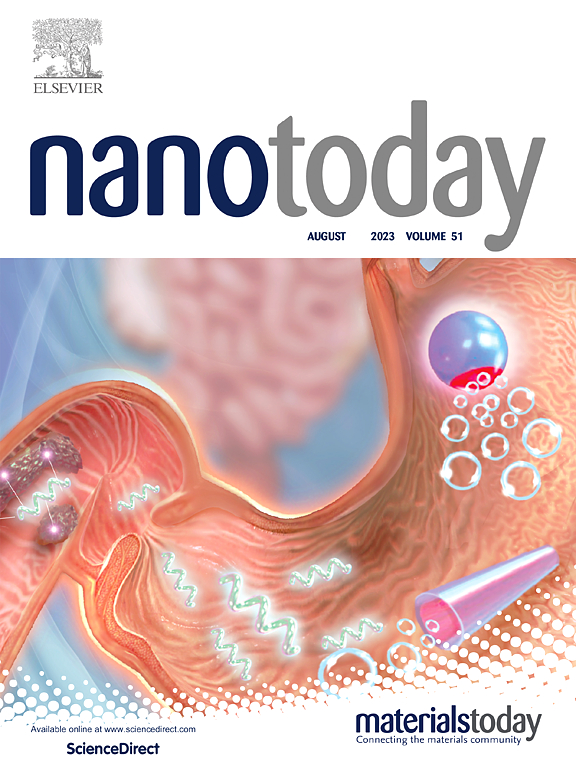抗sv2c单域纳米体在雄激素受体阳性前列腺癌中的分子成像研究
IF 13.2
1区 材料科学
Q1 CHEMISTRY, MULTIDISCIPLINARY
引用次数: 0
摘要
前列腺癌是世界范围内最常见的男性恶性肿瘤之一。由于前列腺癌具有高度的异质性,准确的诊断对于选择合适的治疗策略至关重要。本研究通过噬菌体展示文库筛选,构建了高亲和力的抗SV2C重链抗体可变结构域1-H9纳米体。1-H9显示,SV2C在雄激素受体(AR)阳性的前列腺肿瘤细胞LNCaP中选择性表达,而在AR阴性的前列腺肿瘤细胞PC3中不表达。在LNCaP细胞中,SV2C和AR首次被观察到在线粒体膜上共定位。随后的下拉试验证实,当AR被用作诱饵时,它直接与SV2C(猎物)相互作用,这表明两种蛋白质之间存在物理关联。此外,在临床前列腺癌活检标本中,免疫组化检测显示SV2C和AR染色高度相关。临床前动物模型证实,荧光成像和68Ga PET/CT成像均显示LNCaP肿瘤中SV2C显著富集。我们的研究结果表明,与SV2A用于神经内分泌型PCa诊断不同,SV2C是一种准确诊断AR阳性PCa的新型生物标志物。靶向SV2C-LD4结构域的纳米体1-H9有望作为AR阳性PCa的有效分子成像探针。本文章由计算机程序翻译,如有差异,请以英文原文为准。
Anti-SV2C single domain nanobodies for molecular imaging in androgen receptor positive prostate cancer
Prostate cancer (PCa) is one of the most prevalent malignant tumors in men worldwide. Because of its highly heterogeneous, the accurate diagnosis of PCa is critical to the selection of appropriate treatment strategy. In present work, high affinity nanobody 1-H9, a variable domain of heavy-chain antibody (VHH) against SV2C was developed by phage display library screening. Showing by 1-H9, SV2C was selectively expressed in androgen receptor (AR) positive prostate tumor cell LNCaP, but not AR negative tumor cell PC3. In LNCaP cells, SV2C and AR were first observed to co-localize on the mitochondrial membrane. Subsequent pull-down assays confirmed that AR, when used as bait, directly interacted with SV2C (the prey), suggesting a physical association between the two proteins. Furthermore, on clinical PCa biopsy specimens, SV2C and AR staining were highly correlated in immunohistochemistry assay. Confirmed in pre-clinical animal models, both fluorescence imaging and 68Ga PET/CT imaging showed SV2C was significant enriched in LNCaP tumor. Our results suggest that in contrast to SV2A being used for neuronal endocrine PCa diagnosis, SV2C is a novel biomarker for accurate diagnosis of AR positive PCa. The nanobody 1-H9 developed against SV2C-LD4 domain is promising to be used as an effective molecular imaging probe for AR positive PCa.
求助全文
通过发布文献求助,成功后即可免费获取论文全文。
去求助
来源期刊

Nano Today
工程技术-材料科学:综合
CiteScore
21.50
自引率
3.40%
发文量
305
审稿时长
40 days
期刊介绍:
Nano Today is a journal dedicated to publishing influential and innovative work in the field of nanoscience and technology. It covers a wide range of subject areas including biomaterials, materials chemistry, materials science, chemistry, bioengineering, biochemistry, genetics and molecular biology, engineering, and nanotechnology. The journal considers articles that inform readers about the latest research, breakthroughs, and topical issues in these fields. It provides comprehensive coverage through a mixture of peer-reviewed articles, research news, and information on key developments. Nano Today is abstracted and indexed in Science Citation Index, Ei Compendex, Embase, Scopus, and INSPEC.
 求助内容:
求助内容: 应助结果提醒方式:
应助结果提醒方式:


